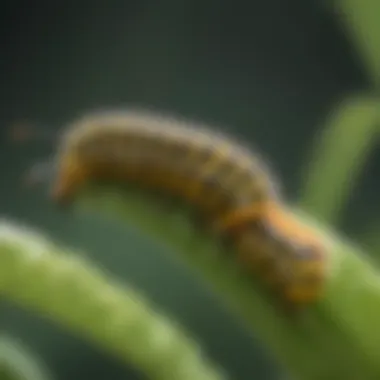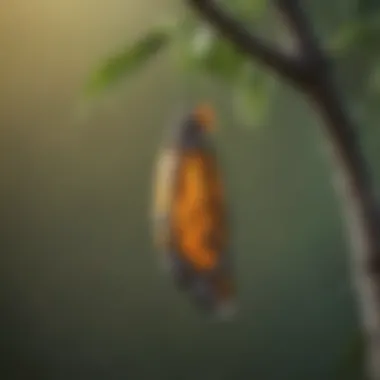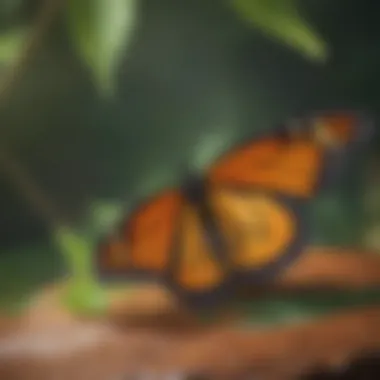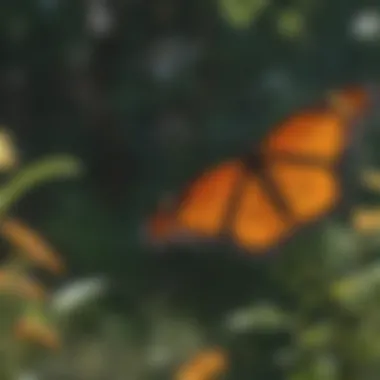The Metamorphosis of Monarchs: Caterpillar to Butterfly


Nature Topic Overview
The life cycle of the monarch is a fascinating example of metamorphosis. This transformation occurs in several stages, each with its unique characteristics. The journey begins when a tiny egg is laid on milkweed. As the egg hatches, the caterpillar emerges, ready to grow. This caterpillar is called a larva, and its main job is to eat. It consumes leaves voraciously. After several stages of growth, known as instars, it enters the next phase.
The caterpillar then forms a protective casing called a chrysalis or pupa. Inside this chrysalis, remarkable changes are happening. The caterpillar’s body is breaking down and reorganizing into the structure of a butterfly. Finally, after a period of time, the chrysalis opens, and a beautiful butterfly emerges.
This entire process not only shows the wonders of nature but also highlights the importance of biodiversity. Understanding this cycle can inspire interest in conservation efforts.
Fun Facts and Trivia
- Monarch caterpillars are bright in color. This bright coloring warns predators that they are poisonous.
- Monarchs can migrate over long distances, some traveling thousands of miles each year.
- The average lifespan of a butterfly is only a few weeks, but those that migrate can live up to eight months.
Interactive elements can help make the learning experience engaging for children. For example, visuals that showcase the transformation stages can enhance understanding.
Wildlife Explorations
Aside from the monarch, there are many fascinating species in its habitat. Some other butterflies include the swallowtail and painted lady. These butterflies also undergo metamorphosis but may have different behaviors and habitats.
Children can learn about the plants these creatures rely on. For instance, milkweed is crucial for monarch caterpillars. Exploration of these plants can provide interesting insights into their role in nature.
Related Animals
- Caterpillars: Many species are not as well-known as the monarch but play important roles.
- Birds: Birds are the main predators of monarchs and other butterflies.
Quizzes can be a fun way to reinforce learning and encourage critical thinking.
Environmental Awareness
The conservation of monarch butterflies highlights the importance of biodiversity. Declines in their population signal problems in ecosystems.
Children can take simple actions to protect nature:
- Plant milkweed in gardens to provide food for caterpillars.
- Avoid pesticides that can harm butterflies and their habitats.
- Participate in local clean-up efforts to protect natural spaces.
By fostering a sense of responsibility, children can become stewards of the environment.
DIY Nature Activities
Hands-on activities can strengthen the understanding of the life cycle. Here are some ideas:
- Create a butterfly garden: Grow milkweed and nectar-rich flowers to attract butterflies.
- Butterfly crafts: Use paper and decorations to create butterfly models, reflecting what they learned during the metamorphosis stages.
- Observation walks: Take children for a nature walk to spot butterflies and observe their behaviors in the wild.
Each of these activities offers a practical way to connect theory to real-world experiences.
The transformation from caterpillar to butterfly is not just about changes in form but also about the cycles of life that connect all creatures.
By exploring this journey, we understand the interdependence of species and the necessity of conservation.
Prelims to Metamorphosis
Metamorphosis is a significant process in the lives of many species, particularly among insects. This change is not just a simple shift; it is a complete transformation. In this article, we focus on the monarch caterpillar and how it undergoes this remarkable journey to become a butterfly. Understanding metamorphosis is essential for grasping the lifecycle of the monarch and appreciating its role in the ecosystem.
Defining Metamorphosis
Metamorphosis involves several stages where an organism drastically changes from one form to another. In the case of the monarch butterfly, this transformation includes different stages: egg, caterpillar, pupa, and adult butterfly. Each stage has distinct characteristics. The egg hatches into a caterpillar, which is also known as the larva. This caterpillar will eat, grow, and shed its skin multiple times before entering the chrysalis stage. Inside this protective casing, it undergoes transformation until it emerges as a butterfly. This process allows the monarch to adapt to different environments and life challenges as it matures.
Importance in Nature


Metamorphosis is not just fascinating; it serves several crucial functions in nature.
- Adaptation and Survival: The change from caterpillar to butterfly allows the monarch to thrive in various ecological niches. Each life stage occupies a different habitat and fulfills different roles in the ecosystem.
- Nutrient Cycling: While caterpillars consume vast amounts of milkweed, they play a role in nutrient cycling by breaking down plant materials. The adult butterflies help in pollination, contributing to plant reproduction.
- Educational Value: Observing metamorphosis provides insights into biological processes. It fosters an appreciation for biodiversity and environmental conservation among younger audiences.
"Metamorphosis is nature's way of ensuring that life continues despite changing conditions."
As we move through this article, we will better understand each stage of the monarch's lifecycle and uncover the environmental factors that influence this transformation.
The Life Cycle of the Monarch Butterfly
The monarch butterfly undergoes a fascinating life cycle that includes four distinct stages: egg, caterpillar, pupa, and adult. Understanding this cycle is crucial for grasping the metamorphosis process and the overall survival strategy of this species. Each stage serves its specific role in the development of the butterfly, showcasing the intricate relationship between biology, behavior, and ecology in nature.
The life cycle also highlights the significance of environmental factors. Monarchs rely on specific plants, like milkweed, for shelter and food. Without these plants, their life cycle would be severely impacted. Furthermore, factors such as climate and predators can dramatically affect their development and survival. Recognizing these elements aids in the conservation efforts aimed at protecting monarch populations.
Egg Stage
The egg stage is the beginning of the monarch's life and plays a critical role in the overall life cycle. The duration typically lasts around three to ten days, depending on environmental conditions. This time frame is essential for ensuring that the eggs hatch when conditions are most favorable for the newly emerged caterpillars.
Duration of Egg Stage
The duration of the egg stage is vital. It ensures the readiness of the caterpillar to adapt to its surroundings. Warmer weather can speed up development, while cold temperatures may delay hatching. This adaptability helps to ensure a higher survival rate in various climates.
A unique feature of this stage is the monarch's preference for laying eggs on specific milkweed plants. This choice maximizes the chances that the hatchlings will have access to their primary food source upon emerging, reinforcing its survival strategy.
Conditions for Hatching
The conditions for hatching refer to the environmental factors necessary for the successful development of the eggs. Proper temperature and humidity levels are crucial. If these conditions are not met, the eggs may fail to hatch.
Moreover, the placement of eggs on the underside of milkweed leaves is a defensive behavior against predators. This reduces visibility and minimizes the chances of being eaten before they can hatch.
Caterpillar Stage
After hatching, the caterpillar stage begins. This stage is primarily focused on growth and development, making it important for the eventual transformation into a butterfly.
Physical Characteristics
The physical characteristics of the caterpillar are intriguing. They are covered in distinct striping patterns, primarily yellow, black, and white, which serve as a warning to predators about their toxicity. This characteristic is vital for their survival.
Another unique feature of this stage is how caterpillars can grow significantly, increasing their size up to 2,000 times their original mass. This rapid growth prepares them for the transformation into their next stage.
Feeding Habits and Growth
The feeding habits of caterpillars are essential. They primarily consume milkweed, which contains toxic compounds. This diet aids in developing their own defense mechanisms against predators. Through this feeding process, they accumulate energy needed for later stages.
As caterpillars feed, they are also growing quickly. This rapid growth allows them to molt several times before entering the next stage of life. Each molt sees increasing body size and a change in skin texture, which is significant for their development.
Pupa (Chrysalis) Stage
The pupa stage is a transformative period where the caterpillar transitions into a butterfly. This stage can be somewhat mysterious due to the changes occurring within the chrysalis.
Formation of the Chrysalis
The formation of the chrysalis involves a caterpillar attaching itself to a firm surface and shedding its skin. This process is called ecdysis. The chrysalis is an extraordinary structure that provides protection during development.
A notable feature of this stage is the vulnerability of the chrysalis. The pupa is susceptible to predators and environmental hazards. The chrysalis serves as a critical barrier, giving the developing butterfly a safe space to undergo significant changes.
Duration and Changes Inside
The duration of the chrysalis stage can vary, generally lasting between 10 to 14 days. During this time, the caterpillar's internal structure is re-organized to form a butterfly. The changes are profound, with all adult structures being created within the protective chrysalis.


The unique aspect of this stage is the rapid rate of transformation. It is critical for developing the butterfly's wings and other physical features, preparing them for their life as an adult.
Adult Butterfly Stage
Once the metamorphosis is complete, the adult butterfly emerges from the chrysalis, marking the final stage of its life cycle.
Emergence from Chrysalis
The emergence from the chrysalis is a pivotal moment. After the appropriate duration, the chrysalis splits, and the adult butterfly must expand its wings. This process is delicate. The newly emerged butterfly needs time for its wings to dry and expand fully before it can fly.
This stage signifies the culmination of the developmental process. It is crucial that butterflies successfully emerge because the adult stage is the final opportunity for reproduction and continuation of the species.
Life Span of Adult Butterflies
The life span of adult butterflies can vary from a few weeks to several months, depending on various factors such as species and environmental conditions. Monarchs, in particular, have a unique migratory pattern that influences their longevity.
A distinctive feature of monarchs is their migratory behavior. They travel thousands of miles, seeking suitable environments for breeding. This behavior plays a significant role in their lifecycle, allowing for new generations to thrive in optimal conditions.
Understanding the Caterpillar
The phase of the caterpillar is critical in the life cycle of the monarch butterfly. There are a few specific elements that make understanding this stage valuable. First, the caterpillar undergoes rapid growth, which prepares it for the significant changes ahead. Second, recognizing the anatomical features and diet of the caterpillar provides insight into its developmental processes. Moreover, comprehending how the caterpillar interacts with its environment enhances our overall understanding of the monarch lifecycle.
Anatomy of the Monarch Caterpillar
Segments and Coloration
The anatomy of the monarch caterpillar is distinct and fascinating. It has a segmented body that is primarily green with black and yellow banding. This coloration serves as a warning to predators about its unpalatability. Monarch caterpillars are popular in educational settings due to this striking appearance and its connection to their survival strategies. The segments are more than just for show; they contribute to the caterpillar's movement and flexibility, which are essential for escaping threats. Some key characteristics of this segmental body structure are:
- Flexibility: This allows for more effective eating and movement.
- Coloration: Bright colors indicate that it is not safe to eat.
While these features have advantages in aiding survival, they also draw attention to the caterpillar in its environment, presenting both benefits and risks.
Defense Mechanisms
The defense mechanisms of the caterpillar are another aspect that should be noted. One primary mechanism is its ability to produce toxins from the milkweed it consumes. These toxins make the caterpillar taste bad to predators. This feature makes the caterpillar a popular choice in studies on evolutionary biology. The idea that a creature can deter predators through diet reflects a unique adaptation. Some additional points about defense mechanisms include:
- Chemical Defense: Consuming milkweed helps the caterpillar become toxic.
- Camouflage: The green color may help it blend with foliage.
Understanding these defense mechanisms allows readers to grasp how adaptations enhance survival in a world filled with dangers. However, reliance on these methods can also mean that, in environments where milkweed is scarce, caterpillars may face greater threats.
Dietary Preferences
Milkweed and Its Importance
Milkweed plays an indispensable role in the lifespan of a monarch caterpillar. It is the exclusive food source for monarch larvae. This relationship is significant for several reasons. First, the nutritious leaves help the caterpillar grow rapidly. Second, milkweed contains toxins that are stored in the caterpillar's body, which later protect the adult butterfly from being eaten. Some highlights about milkweed include:
- Nutritional Value: Full of carbohydrates and proteins needed for growth.
- Toxic Properties: Deters many potential predators.
This key association between the caterpillar and milkweed underscores the delicate balance in nature's food webs. Without a plentiful supply of milkweed, caterpillars face the risk of starvation and diminished survival odds.
Nutritional Needs
The nutritional needs of the caterpillar are quite specific. A steady intake of milkweed ensures that it grows efficiently and can enter the next stages of metamorphosis. Providing the right environment for these caterpillars involves understanding their basic requirements:
- Consistency: They need constant access to milkweed to sustain their growth.
- Water: While they get moisture from the leaves, they need healthy, hydrated plants.
This knowledge is beneficial for conservation efforts, as it informs how to maintain habitats. Understanding the dietary needs ensures that audiences appreciate the unique demands of the caterpillar stage and the importance of protecting its feeding grounds.
Environmental Factors Affecting Development


Understanding how environmental factors influence the development of monarch butterflies is crucial. These elements play a significant role in the success of their life cycle. Factors like climate and the presence of predators can determine the survival rates of both caterpillars and adult butterflies.
Climate Impact
The climate has a profound effect on the lifecycle of the monarch butterfly. Temperature and humidity are two main factors that influence changes in development. For instance, ideal temperatures are necessary for the growth of eggs and caterpillars. If it gets too cold or hot, it can slow down their development or even kill them. Additionally, humidity affects egg survival. Too much moisture can lead to fungal infections, harming the young caterpillars.
Predators and Threats
Predators pose a real threat to the survival of monarch butterflies. They target various stages in the life cycle, especially the vulnerable caterpillar stage.
Natural Predators
Natural predators include birds, mammals, and insects. Birds often notice the bright stripes of monarch caterpillars, signaling that they are toxic after feeding on milkweed. This toxicity is a key characteristic that helps reduce their chances of being eaten. However, not all predators know this. Some can consume caterpillars without facing any consequences. This indicates that predators play a complex role in the survival of monarchs, affecting their population numbers.
Human Impact
Human impact is another serious threat to monarch populations. Urban development leads to habitat loss, which leaves fewer places for these butterflies to thrive. Pesticides used in farming can also endanger them by reducing food sources, such as milkweed. Monitoring their habitats and understanding how human activities influence these delicate ecosystems can help emphasize the urgency of conservation efforts.
In essence, understanding the effect of both natural circumstances and human actions on the monarch butterfly's development is essential for effective conservation strategies.
Overall, these environmental factors contribute significantly to the lifecycle of monarch butterflies. It is important to recognize and protect their habitat while also considering the impact humans can have on their existence. By doing so, we ensure that this beautiful creature continues to grace our natural world for generations to come.
Conservation of Monarch Butterflies
The conservation of monarch butterflies is crucial in ensuring the survival of this species. Monarch butterflies face numerous threats, including habitat loss, climate change, and pesticide use. As such, understanding the importance of conservation efforts is essential for protecting both the butterflies and the ecosystems they inhabit. Conservation is not just about saving a single species; it impacts the broader ecological network. Monarchs contribute to the pollination of many plants, which in turn supports other wildlife.
Importance of Conservation Efforts
Conservation efforts focus primarily on protecting the habitats that monarchs rely on during their life cycle. These habitats provide essential resources such as food and shelter. Strategies include planting milkweed, which serves as a host plant for laying eggs and a food source for caterpillars. Preserving migratory routes also plays a key role. By maintaining these pathways, we allow monarchs to complete their incredible migrations between North America and Mexico. Protecting these areas not only aids the monarchs but also benefits countless other species that share these ecosystems.
Ways to Help Monarch Butterflies
Helping monarch butterfles can be simple and impactful. Here are some practical steps to contribute to their conservation.
Planting Milkweed
One of the most effective ways to support monarch butterflies is by planting milkweed. This plant is crucial for the survival of the caterpillars. Milkweed contains toxic compounds that make the caterpillars distasteful to predators. This feature enhances their survival chances in the wild. Additionally, choosing the right species of milkweed can enhance the growth potential in various climates. However, it’s important that people educate themselves on the specific types of milkweed best suited for their areas, as not all species survive in every environment.
Creating Butterfly Gardens
Creating butterfly gardens is another powerful method for supporting the butterfly population. These gardens can provide food sources and shelter for adult butterflies. Include diverse nectar-producing flowers to attract a range of species, not just monarchs. An effective butterfly garden is easy to create and requires little maintenance once established. When setting up a butterfly garden, consider the local environment and select plants that thrive in that climate. It is beneficial as these gardens can educate children and families about the importance of biodiversity while providing a supportive habitat for these delicate creatures.
"The efforts to conserve monarch butterflies not only help enhance biodiversity but also foster greater ecological awareness among communities."
In summary, the conservation of monarch butterflies is critical. Through understanding the importance of habitat protection and adopting simple practices like planting milkweed and creating butterfly gardens, individuals can play a significant role in ensuring the survival of these beautiful insects.
Ending
The significance of understanding the transition from a monarch caterpillar to a butterfly encompasses many areas of nature and science. This metamorphosis illustrates the complexity and beauty of biological processes. Each phase, from egg to caterpillar to chrysalis and finally to adult butterfly, is not merely a transformation; it is an intricate dance of growth, change, and adaptation.
By educating ourselves and others about this cycle, we foster a sense of wonder and respect for these creatures. The insights gained from studying monarchs can also lead to greater awareness of environmental issues. Recognizing the delicate balance within ecosystems enhances our understanding of how each species plays a vital role.
In addition, conservation efforts gained from this knowledge can have tangible benefits. By taking action to protect the habitats of monarchs, we also safeguard the broader environment. Therefore, knowledge about this metamorphosis not only enriches our understanding but also empowers us to contribute positively to nature's balance.
"The transformation of a monarch butterfly serves as a profound reminder of nature's resilience and the importance of preserving biodiversity."
Summary of Key Points
- The transformation journey of the monarch includes distinct stages: egg, caterpillar, chrysalis, and adult butterfly.
- Each stage plays a critical role in the overall lifecycle.
- Understanding these stages helps highlight the need for conservation efforts.
- The interplay between the monarch's life cycle and its environment shows the interconnectedness of ecosystems.
- Protecting habitats means protecting many species reliant on similar environments.
Final Thoughts on Monarchs and Nature
Monarch butterflies are not just beautiful insects; they symbolize the intricate connections within ecosystems. As we examine their life cycle, we gain insights that resonate beyond their individual lives. The story of the monarch is a testament to resilience, adaptation, and the delicate balance present in nature. This encourages learners, including children, parents, and educators, to appreciate and engage with the natural world more deeply. With this understanding comes the responsibility to protect it.
Ultimately, the journey from caterpillar to butterfly serves as a vivid metaphor for change and growth, emphasizing that with time and the proper environmental conditions, transformation is possible. As stewards of the planet, fostering this knowledge in younger generations is crucial, ensuring that monarchs and their habitats thrive for years to come.







